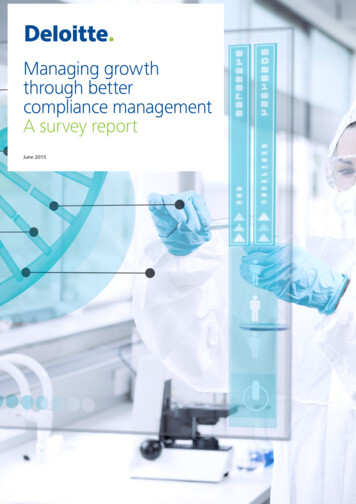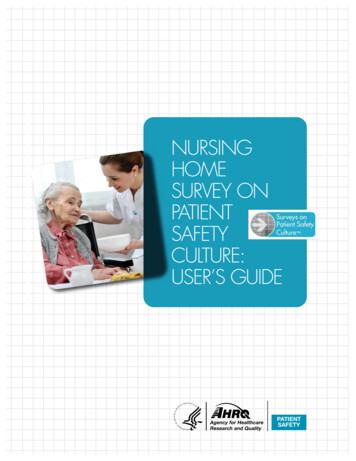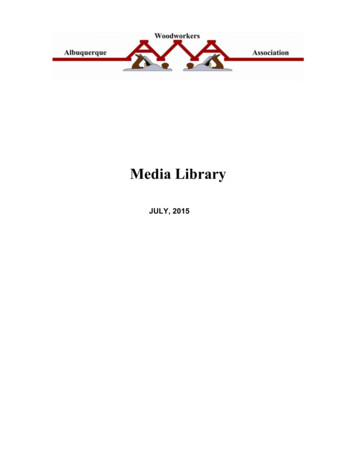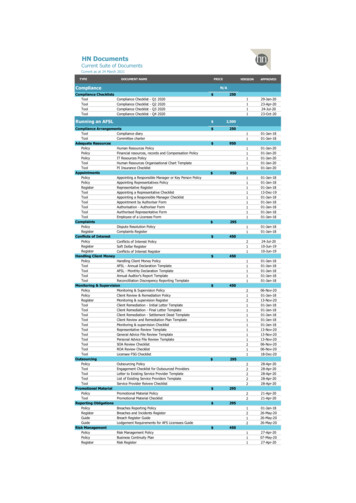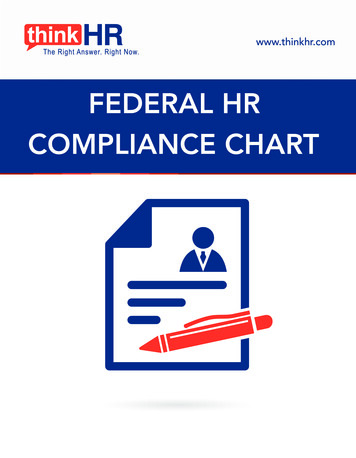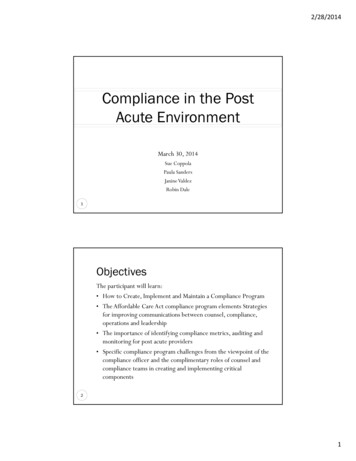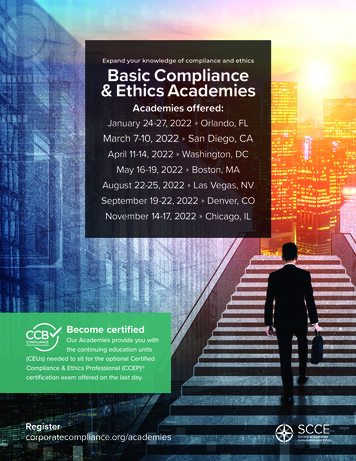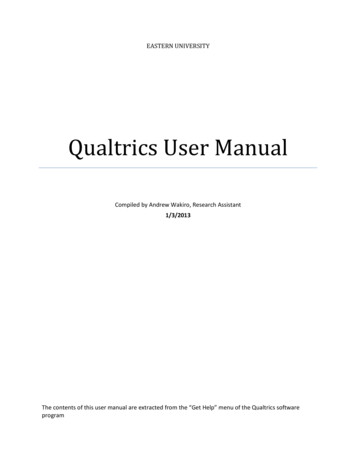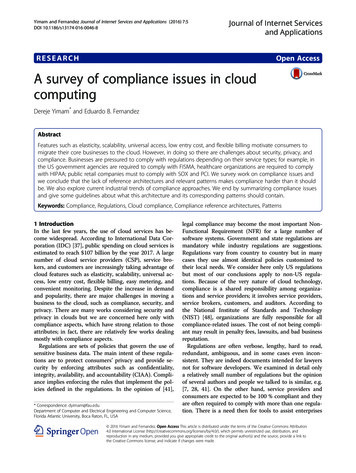
Transcription
Yimam and Fernandez Journal of Internet Services and Applications (2016) 7:5DOI 10.1186/s13174-016-0046-8Journal of Internet Servicesand ApplicationsRESEARCHOpen AccessA survey of compliance issues in cloudcomputingDereje Yimam* and Eduardo B. FernandezAbstractFeatures such as elasticity, scalability, universal access, low entry cost, and flexible billing motivate consumers tomigrate their core businesses to the cloud. However, in doing so there are challenges about security, privacy, andcompliance. Businesses are pressured to comply with regulations depending on their service types; for example, inthe US government agencies are required to comply with FISMA, healthcare organizations are required to complywith HIPAA; public retail companies must to comply with SOX and PCI. We survey work on compliance issues andwe conclude that the lack of reference architectures and relevant patterns makes compliance harder than it shouldbe. We also explore current industrial trends of compliance approaches. We end by summarizing compliance issuesand give some guidelines about what this architecture and its corresponding patterns should contain.Keywords: Compliance, Regulations, Cloud compliance, Compliance reference architectures, Patterns1 IntroductionIn the last few years, the use of cloud services has become widespread. According to International Data Corporation (IDC) [37], public spending on cloud services isestimated to reach 107 billion by the year 2017. A largenumber of cloud service providers (CSP), service brokers, and customers are increasingly taking advantage ofcloud features such as elasticity, scalability, universal access, low entry cost, flexible billing, easy metering, andconvenient monitoring. Despite the increase in demandand popularity, there are major challenges in moving abusiness to the cloud, such as compliance, security, andprivacy. There are many works considering security andprivacy in clouds but we are concerned here only withcompliance aspects, which have strong relation to thoseattributes; in fact, there are relatively few works dealingmostly with compliance aspects.Regulations are sets of policies that govern the use ofsensitive business data. The main intent of these regulations are to protect consumers’ privacy and provide security by enforcing attributes such as confidentiality,integrity, availability, and accountability (CIAA). Compliance implies enforcing the rules that implement the policies defined in the regulations. In the opinion of [41],* Correspondence: dyimam@fau.eduDepartment of Computer and Electrical Engineering and Computer Science,Florida Atlantic University, Boca Raton, FL, USAlegal compliance may become the most important NonFunctional Requirement (NFR) for a large number ofsoftware systems. Government and state regulations aremandatory while industry regulations are suggestions.Regulations vary from country to country but in manycases they use almost identical policies customized totheir local needs. We consider here only US regulationsbut most of our conclusions apply to non-US regulations. Because of the very nature of cloud technology,compliance is a shared responsibility among organizations and service providers; it involves service providers,service brokers, customers, and auditors. According tothe National Institute of Standards and Technology(NIST) [48], organizations are fully responsible for allcompliance-related issues. The cost of not being compliant may result in penalty fees, lawsuits, and bad businessreputation.Regulations are often verbose, lengthy, hard to read,redundant, ambiguous, and in some cases even inconsistent. They are indeed documents intended for lawyersnot for software developers. We examined in detail onlya relatively small number of regulations but the opinionof several authors and people we talked to is similar, e.g.[7, 28, 41]. On the other hand, service providers andconsumers are expected to be 100 % compliant and theyare often required to comply with more than one regulation. There is a need then for tools to assist enterprises 2016 Yimam and Fernandez. Open Access This article is distributed under the terms of the Creative Commons Attribution4.0 International License (http://creativecommons.org/licenses/by/4.0/), which permits unrestricted use, distribution, andreproduction in any medium, provided you give appropriate credit to the original author(s) and the source, provide a link tothe Creative Commons license, and indicate if changes were made.
Yimam and Fernandez Journal of Internet Services and Applications (2016) 7:5or software houses when implementing software systemsthat must be compliant, but we have found that the lackof a vendor-neutral standard compliance ReferenceArchitecture (RA) is a basic challenge for service providers, service brokers, consumers, and auditors. An RAis a standardized, generic software architecture, with noplatform dependencies, valid for a particular domain [4].An RA can be used to guide system design and development; it can also be a reference to indicate where thespecific compliance policies should be applied in the system architecture. An RA can serve as a common language among stakeholders including business owners,managers, architects, developers, testers, and auditors.References [9, 34, 35, 49, 51, 61] describe RAs intendedto guide compliance. There is no accepted definitionabout what an RA should contain; the available compliance RAs are either vendor specific, lack standard modeling, or are incomplete. In addition, the style and thedepth of the architectures are different among vendors.As a result, consumers are challenged to evaluate serviceproviders with no standard compliance RAs that couldbe used as a common reference and checklist. In particular, when negotiating service contracts it is hard forboth consumers and providers to define precisely what itmeans to be compliant with some regulation. One of theobjectives of this paper is to indicate what aspectsshould be included in such an RA. Some of the regulations have been described by patterns and we indicatealso how a catalog of compliance patterns can help tobuild a compliance RA. We do not provide here an idealarchitecture or discuss how to build one, but we havedone that in [64].Often, compliance and security are only addressed either at the testing phase or at the last stage of development, which could potentially result in applications thatdo not identify potential threats. In order to build goodquality and compliant systems, it is critical to considerthe enforcement of regulations at all developmentphases including requirements, design, implementation,and testing phases. An RA emphasizes the need to startfrom a conceptual view of the semantics of the regulations without getting prematurely involved into implementation details. In [22] we showed the value of an RAas a way to enumerate threats and indicate where countermeasures should be placed. Since compliance isstrongly based on security measures and related policies,it is clear that an accepted RA describing specific regulations would provide a way to facilitate building systemsthat comply with the corresponding regulations. We willconsider the use or lack of RAs as a criteria to judge thepublications we analyze in our survey. RAs can be builtusing patterns and use of patterns is another way tomake explicit compliance with policies. A pattern is asolution to a recurring problem in a specific context,Page 2 of 12typically expressed using UML (Unified Modeling Language) models [8].An RA would be a great help to build new regulationsby identifying commonalities. Identifying overlaps andpatterns among regulations can avoid duplicate implementations and inconsistencies as well as allow considering known security threats [23]. Reference [28]identified 31 technical security features that are commonfor FISMA [24], HIPAA [33], PCI [52] and ISO [39].They concluded that implementing compliance guidelines for FISMA could cover compliance for HIPAA,PCI and ISO with the exception of privacy. Reference[30] built a citation graph to analyze interrelated regulations, overlaps, and possible conflicts. Reference [45]identified overlaps among GLBA, HIPAA, PCI DSS, andSOX regulations. These commonalities are important incomplying with multiple regulations and for understanding regulations in general.Most businesses use independent third party certifyingagencies [15] and internal IT auditors to assure compliance, security, and privacy. In addition, governmentagencies in the US that support cloud computing mustfulfill the Federal Risk and Authorization ManagementProgram (FedRAMP) [16]. The US government published the list of FedRAMP certified cloud service providers [15] and Third Party Assessment Organizations(3PAOs) [17] that can be used as a reference for anycloud service providers and consumers. Service providers such as Amazon, IBM, Microsoft, Oracle, HP andothers claim compliance by certifying their cloud services with 3PAOs. We survey here some industrial compliance efforts. Based on the survey of publications andindustrial practice we discuss their significant issues andprovide guidance about how this architecture should be.Section 2 describes some background about regulations, patterns, and RAs. We survey compliance publications in Section 3 and compliance approaches inindustry in Section 4. Section 5 summarizes complianceissues and recommendations. We end with some conclusions and future research directions in section 6.2 BackgroundIn this section we describe some background about regulations, standards, patterns, and RAs.2.1 Regulations and standardsWe summarize below some of the common regulationsin the U.S.HIPAA (Federal regulation): Healthcare organizationsare required to comply with the Healthcare InsurancePortability and Accountability Act (HIPAA) [33]. Themain objective of HIPAA is to ensure the security andprivacy of Protected Health Information (PHI). PHI includes patient medical records, personal information,
Yimam and Fernandez Journal of Internet Services and Applications (2016) 7:5credit information, insurance, employment information,and any related information that helps to identify an individual. HIPAA categorizes participating entities as covered entities and business associates. Covered entitiesinclude health care providers, health insurers, and healthcare clearinghouses (i.e. entities that manage billing services and process medical records that come from othersystems). Business associates are entities that transfer,store, and service protected health information on behalfof covered entities. HIPAA has five major rules [33]:Page 3 of 12 Develop and maintain secure systems andapplications Restrict access to data by using a need-to-knowpolicy Identify and authenticate access to systemcomponents Restrict physical access to cardholder data Track and monitor access to network andcardholder data Regularly test security systems and processes Maintain an information security policy Privacy rule: health providers must notify individuals of the use of their health information. In addition,health providers must regulate the use anddisclosure of PHI.Security rule: regulates the security of PHI frombreaches, unauthorized access, deletion, andmodification held by covered entities and businessassociates. This rule complements the Privacy ruleby defining ways to protect its information.Transaction and Code Sets rule: Regulates medicaltransactions, medical coding standards, andreporting.Enforcement rule: it sets money penalties forviolating HIPAA rules and establishes proceduresfor investigations and hearings for HIPAA violations.It regulates the use and disclosure of ProtectedHealth Information for law enforcement officials.Unique identifier rule: prescribes that employers andparticipating parties are required to have uniqueEmployer Identification Numbers (EIN) to use fortheir transactions. Each medical transaction isrequired to have a unique ID and code set.Sarbanes-Oxley Act (SOX) (Federal regulation): SOXestablishes standards for all US publicly-traded companies to protect shareholders and the general public fromaccounting errors and fraudulent practices [57]. SOX enforces control on user management, auditing, reporting,security and privacy analysis, authorization, authentication, system development, program and infrastructuremanagement, monitoring, backup, and disaster recovery.Its rules are as follows [57]: Establish safeguards against fraudulent financial PCI-DSS (Credit Card industry regulation): Companiesthat handle cardholder information are required to comply with the Payment Card Industry Data SecurityStandard (PCI DSS) [52]. Cardholder information includes debit, credit, prepaid, ATM, and Point of Sale(POS) cards. PCI recommends that only authorizedusers have access to manage cardholder data. PCI hastwelve major rules to protect cardholder data includinginstallation of firewalls, resetting default password andsecurity parameters, authentication, authorization, encryption, and others. Its rules are as follows [52]: report, including data accuracy and correctiontimeline.Disclose compliance and security safeguards toindependent auditors, including security policies,changes, application and system logs, andoperations.Establish safeguards to prevent unauthorized datatamperingEstablish safeguards to track data access andchangesRegularly test security systems, policies, andprocessesMaintain an information security policyDetect and notify security breachesGramm-Leach-Bliley Act (GLBA) (Federal regulation):It requires institutions that offer financial products orservices to consumers to develop, implement, and maintain a comprehensive information security program thatprotects the confidentiality and integrity of customer records [29]. Its rules include: Privacy rule - disclosure policies and procedures on Install and maintain a firewall configuration to protect cardholder dataDo not use default passwords or security parametersProtect stored cardholder dataEncrypt transmission of sensitive information acrosspublic networksUse and regularly update anti-virus and malwareprotectionhow consumer’s data is protected and used. Safeguard rule – maintain comprehensive securitypolicies. Security policies need to be applied to allwith no exception and need to be reviewed, tested,and maintained frequently.Control Objectives for Information and RelatedTechnology (COBIT), (IT industry regulation): It is a
Yimam and Fernandez Journal of Internet Services and Applications (2016) 7:5standard to provide IT governance and control. It attempts to ensure the integrity of information and information systems by providing technical guidelines oninformation security, compliance, governance, audit, andrisk management [11].The Federal Information Security and ManagementAct (FISMA), (Federal government regulation): FISMAapplies to government agencies and affiliated companiesthat collect and process data on behalf of governmentagencies [24]. It provides guidelines on security controls,user access, identity management, risk assessment,auditing, and monitoring.ISO/IEC 27000 (IT industry regulation): It is a generalsecurity guideline for all types of organization includingcommercial enterprises of all sizes [39]. It is a family ofstandards that helps organizations to secure informationassets. Some of its standards are:ISO/IEC 27001 –Information security managementsystems requirementsISO/IEC 27002 – Code of practice for informationsecurity controlsISO/IEC 27003 – Information security managementsystem implementation guidanceISO/IEC 27004 - Security techniques – Informationsecurity managementISO/IEC 27002 defines six access control objectivesthat cover end user, privileged user, network, application,and information. The objectives include control accessto information, manage user access rights, apply goodaccess practices, control access to network services, control access to operating systems, and control access toapplications and systems [42].These regulations and standards are used in servicesectors such as healthcare, finance, retail, communication, energy, education, and government agencies.Table 1 shows a summary of a few service sectors withtheir corresponding regulations. In most cases, servicesectors support multiple regulations to comply with government and industry regulations. As mentioned earlier,many countries have similar regulations and standardscustomized to their local needs. For example, the European Union Data Protection Directive law (EU DPD) hasa set of policies to protect the confidentiality, integrity,Table 1 Summary of service sectors with their correspondingregulationsService sectorRegulation1HealthcareHIPAA, PCI2RetailPCI, SOX3FinancialPCI, SOX, and GLBA4Government agenciesFISMAPage 4 of 12availability, and accountability of personal data [44]. EUcountries are required to comply with these policies.2.2 PatternsA pattern encapsulates a solution to a recurring problemin a specific context. Patterns can be used to analyzecomplex systems, to capture design decisions, assumptions, and experiences. They can improve software quality by promoting reusability, scalability, and consistency.Patterns can be categorized as analysis patterns [19, 25],design and architecture patterns [8, 26], and securitypatterns [18, 20]. Pattern solutions are usually represented using modeling languages such as the UnifiedModeling Language (UML), maybe combined with formal languages such as the Object Constraint Language(OCL) [63]. Patterns may include class diagrams, sequence diagrams corresponding to use cases, and statediagrams, and they are described using templates. A fewpatterns exist to describe the architectural implicationsof regulation policies [14, 21].2.3 Reference Architectures (RAs)As defined earlier, a Reference Architecture (RA) is ageneric abstract architecture, valid for a particular domain (or set of domains), with no implementation aspects or vendor specific details [4, 60]. RAs are specialtypes of architectures intended to understand, analyze,design and standardize complex systems at a high levelof abstraction. RAs are reusable, extendable, and configurable; that is, they are kinds of patterns for whole architectures and can be instantiated into specific softwarearchitectures by adding platform aspects. Software architectures derived from RAs could mitigate risks, facilitatecompliance, and protect confidentiality and integrity ofconsumers’ data [10, 62]). RAs can become a commonlanguage among stakeholders including business owners,managers, architects, developers, testers and auditors.RAs can also be used to standardize application design,implementation, and verification. RAs can be built ofpatterns and there is also a possibility of identifying newpatterns while building them. In addition, block diagrams, reference models, viewpoints, use cases, and formal languages can be used to build RAs.3 Survey of compliance in cloud computingThere are only a few papers that have direct relationshipto our survey. We review papers that discuss general aspects of regulations or which consider compliance withspecific regulations.Reference [48] identified a number privacy and security related issues that could have an impact on cloudcomputing. The paper covers issues and recommendations on governance, compliance, trust, architecture,identity, access management, software isolation, data
Yimam and Fernandez Journal of Internet Services and Applications (2016) 7:5protection, availability, and incident report. The paperpointed out that compliance in cloud computing is oneof the complex issues to deal with as policies vary fromcountry to country. As per [48], understanding and enforcing regulations are also a major challenge in cloudcomputing. They analyzed the impact of data location,loss of control, and transparency in public cloud compliance. The issue of electronic discovery that involvesidentification, collection, processing, analysis, and production of stored information is also covered. The authors didn’t cover techniques to map complex policiesinto best practices, patterns, or RAs. They also mentioned that most cloud service providers use third partycertification to confirm their compliance. As per oursurvey, third party auditors are using proprietary solutions that lack vendor neutral models or architecturesthat can be used as a checklist by all stakeholders.Reference [45] compared GLBA, HIPAA, PCI andSOX standards on the basis of generating reports for auditors. Their findings showed that some reports and services share common features including user logonreport, user logoff report, user failure report and logs access report as shown in Table 2. They concluded thatSOX compliance with respect to reports also covers therequired reports for GLBA, HIPAA and PCI-DSS. Theauthors didn’t cover other features of compliance suchas privacy, security, user management, and notification.The comparison table would have been more precise ifit was backed by more precise artifacts.Reference [55] analyzed the top seven threats and theirpossible impact on cloud compliance by mapping threatsto applicable regulations. The mapping could be used asa reference to evaluate compliance. However, the paperlacks explicit mappings between compliance and securitythreats. For example, in Table 3 threats # 2 and #3 arePage 5 of 12not mapped to any compliance standard. The paper alsolacks a precise definition of threats and their corresponding correlation with compliance. For example, theyconsider threats #2 and #3 as threats but they are vulnerabilities. The authors left out other regulations suchas SOX and GLBA and did not try to define an RA.Note also that this list of threats is rather incomplete;for a more comprehensive list see [31, 55].Reference [54] reviewed privacy regulations in thecloud. They pointed out that there are still many uncertainties with respect to compliance and privacy in cloudcomputing. As a result, it is becoming very difficult toanalyze security, privacy and compliance among cloudservice providers. In addition, they indicated that manyregulations share common requirements such as privacy,integrity, security and enforcement. They mentionedthat organizations are liable in the case of securitybreaches and lawsuits. They also reviewed the use of independent third parties to certify compliance.Reference [46] analyzed HIPAA and COBIT with respect to NIST guidelines. According to [46], healthcareorganizations that adopt COBIT as their standard willimmediately satisfy 50 % of the NIST standards. Theyconcluded that an increase in security threats, complexregulations, lack of qualified security experts, and highimplementation and maintenance costs are the mostcommon challenges in the healthcare industry. Inaddition, the authors pointed out that company compliance can be improved by analyzing regulation overlapsand best practices. The overlap was presented in blockdiagrams which do not show clearly the type and the nature of these overlaps.Reference [30] built a citation graph that could be usedby analysts to navigate through the various interrelatedregulations to uncover overlaps and possible conflicts orTable 2 GLBA, HIPAA, PCI DSS and SOX report comparison [45]ReportsGLBAHIPAAPCI-DSSSOXUser logon / Logoff Logon failure Audit logs access Object access System events Host session statusSecurity log archiving Track account management and use group changes Track audit policy changes Successful user account validation Unsuccessful use account validation Track individual user actions reportTrack application access
Yimam and Fernandez Journal of Internet Services and Applications (2016) 7:5Page 6 of 12Table 3 Threats to compliance mappingThreatsRemarks1 Abuse and Nefarious Use of Cloud Computing - threats related toabusing cloud network and services by using Denial of Service (DoS),malicious file upload, and malware- The authors mapped this threat to ISO 27001 compliance. We believethat this threat can also be mapped to other regulations2 Insecure Interfaces and APIs- This is not a threat, it is a vulnerability.3 Malicious Insiders- Not a threat, a vulnerability. It is not mapped to any regulation4 Shared Technology Issues- The authors mapped the threat to ISO 27000–27002 and PCI-DSScompliance. We believe that this threat can also be mapped to otherregulations5 Data Loss or Leakage- The authors mapped this threat to ISO 17826 and HIPAA compliance.We believe that this threat can also be mapped to other regulations6 Account or Service Hijacking- There is no clear mapping between this threat and availableregulations7 Unknown Risk Profile – it includes transparency, maintenanceresponsibility, software version, and fixes- The mapping between regulations and this threat is not clear.to understand compliance documents. The authors useda decision support system to identify compliance similarities and differences. They used this citation graph tounderstand regulations, to uncover overlaps and possibleconflicts. They also use the citation graph to detect important provisions by ranking, to assess the impact ofchange in a particular act, and to validate consistency.The overlaps include security, notification, reporting,and user management. The authors focused only onHIPAA, SOX and GLBA regulations. We can also assertthat [45] findings confirm [30] conclusions.Reference [6] developed a compliant cloud computing(C3) framework to address security, compliance, privacy,and trust issues. According to the authors, C3 can beused to address data privacy by enforcing data storage inspecific regions and by applying data fragmentation.They claim that the framework can be used as a brokerto integrate multiple service providers. The authors proposed a domain specific language (DSL), a metamodeland an activity diagram to analyze regulations such asHIPAA, PCI and SOX.Reference [13] developed a framework called MEGHNAD [13] that uses a Multi-Objective Genetic Algorithm (MOGA) to determine an optimal security toolsetthat could meet security and compliance requirements.The authors claim that the framework can be used togenerate compliance checklists and Service Level Agreements (SLAs). They also used the framework to analyzesecurity levels and cloud assurance levels for IaaS, PaaSand SaaS.According to [12], security and compliance tools couldhelp organizations to certify compliance. They reviewedcompliance tools such as WatchGuard and Trust Waveto analyze, and generate compliance coverage reports.The depth and scope of the reports vary from vendor tovendor. The authors categorized service models anddefined a compliance mapping matrix based on “whocontrols what” as shown in Tables 4 and 5. The definitions in these tables are not detailed enough to showprecisely the roles of the users of a cloud. For example,access control is a shared responsibility but it is indicated as vendor responsibility in Table 4. In Table 4, requirements 3 and 5 are the same by definition; however,the authors provide different roles for IaaS responsibility.They covered HIPAA and PCI standards but these conclusions may not apply to other standards. The authorssuggested that more research needs to be done in orderto build consumers’ confidence and trust.Reference [47] discussed PCI compliance challengesand solutions. The authors reviewed challenges such ascosts, overlaps, legal uncertainties, security, maintenance, complexity, code quality, and new technologies.Their proposed solutions are based on best practices.The solutions include authentication, authorization, encryption, and monitoring. The authors didn’t cover howto address regulation complexities and overlaps.Reference [28] analyzed security overlaps amongFISMA, HIPAA, PCI and ISO. The author identified 31technical security features that are common to FISMA,HIPAA, PCI and ISO and suggested that implementingthe compliance guidelines of FISMA could cover compliance of HIPAA, PCI, and ISO, with the exception ofprivacy. The paper also confirms regulation overlaps andthe need for the systematic approaches proposed by [45,47, 55].Reference [44] reviewed the EU DPD law and regulations in the context of cloud computing. They pointedout that parts of the DPD policies are not clear, including the definition of sensitive personal data, the roles ofcontrollers and processors. The authors also mentionedthat there are overlaps among regulations. They used anenumeration approach to map the DPD policies to available best practices. They proposed encryption, anonymization, and pseudonymization to secure personal data in
Yimam and Fernandez Journal of Internet Services and Applications (2016) 7:5Page 7 of 12Table 4 Vendor responsibility for HIPAA Requirement Mapping matrix [12]HIPAA requirementVendorresponsibility inSaaS PaaS IaaS1 Security Management Process: Review permission setting and correct access rightsYesNoNo2 Assigned Security Responsibility: Identify the security official who is responsible for the development and implementation ofthe policies and procedures.YesNoNo3 Workforce Security: Ensure that only authorized workforce members have access to Electronic Protected Health InformationYesYesNo4 Information Access Management: Implement policies and procedures for accessing Electronic Protected Health InformationYesYesNo5 Access Control: Allow access only to the authorized workforceYesYesYes6 Audit Control: Record and examine activities for Electronic Protected Health InformationYesYesYesthe cloud. One of the problems with enumerations isthat they lack a conceptual model of how the requirements relate to each other.Reference [14] proposed a Compliance Request Languages that can be used to specify compliance patternsthat can be applied to business processes. They builtdesign-time compliance management framework thatcan be used to automate compliance validation and verification. They made
with HIPAA; public retail companies must to comply with SOX and PCI. We survey work on compliance issues and we conclude that the lack of reference architectures and relevant patterns makes compliance harder than it should be. We also explore current industrial trends of compliance approaches. We end by summarizing compliance issues


